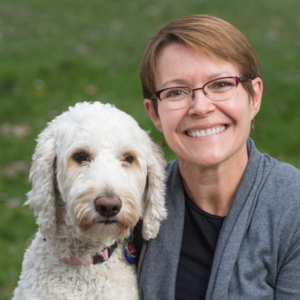As Susan Lana, DVM, leads a visitor on a tour of the Flint Animal Cancer Center (FACC) at Colorado State University, pointing out labs, clinics, technology, and an army of medical staff members tending to sick dogs and cats, she smiles when her impressed guest lets out a “Wow!”
“You’ll do a lot more wowing as we go,” she promises.
Lana in October was named director of the FACC and its staff of about 100, housed at the sprawling James L. Voss Veterinary Teaching Hospital on CSU’s Fort Collins campus. She has a long association with the FACC and with CSU, where she earned her Doctor of Veterinary Medicine degree in 1993 and joined the faculty in 1999. She was the center’s oncology service section head for 15 years.
As impressive as the facility is, it’s also impressive to learn about the cancer research underway at the FACC – research that often leads to benefits for both furry friends and human cancer patients.
→ Growing Evidence Shows Increasing Overlaps Between Human and Companion Animal Cancer Research
In fact, the FACC is a key research partner of the University of Colorado Cancer Center, of which Lana and a number of other FACC researchers are members. They collaborate on one of the most advanced comparative oncology research programs in the world, seeking to translate research on prevention, diagnosis, and treatment of cancer in pet animals to benefit people.
“Our comparative oncology research that’s translationally relevant takes advantage of the fact that dogs and cats get cancer spontaneously, as opposed to mice and rats, who might have it induced as a research model. And then a lot of the cancers that we see are very similar to the cancers that people get,” Lana says. “So, by studying those cancers here, hopefully we can move the needle in human medicine as well as veterinary medicine.”

Megan Gutwillig, DVM (left), and Lisa Losorelli, BVMS, work in the clinical trials space at CSU's Flint Animal Cancer Center. Photo by Mark Harden | CU Cancer Center.
Faster clinical trials
The FACC’s staff of basic scientists and clinical investigators conduct more than a dozen research programs studying cancer biology, clinical pathology, clinical immunology, radiation and surgical oncology, and more. They regularly team up with CU Cancer Center investigators on treatment strategies that can be more quickly studied in pet dogs, informing later studies in people. They typically have 15 to 20 clinical trials running at any given time on new cancer therapies that often take a fraction of the time as human trials.
The FACC is home to the CU Cancer Center’s Pharmacology Shared Resource (PharmSR), supporting researchers and clinicians to design and implement studies to measure xenobiotics (drugs, toxicants, natural products, and more) in biological systems. The FACC’s Molecular Oncology and Functional Genomics Laboratory maintains dozens of canine and feline cell lines. And its Biorepository, established by Lana in 2003, houses about 30,000 tissue and fluid samples from animals with cancer and is a resource for researchers nationwide.
→ Studying the Oral Cancer Immune Landscape in Dogs
On the clinical side, Lana says, the FACC’s clinic is multidisciplinary, with medical oncologists, surgical oncologists, and radiation oncologists on staff. It brings an arsenal of weapons to bear similar to those employed by a major human cancer center, bolstered by advanced imaging, anesthesia, and critical care expertise. The FACC also plays a role in teaching veterinary students and training residents as part of CSU’s College of Veterinary Medicine and Biomedical Sciences.
“Dr. Lana’s deep expertise as a clinician, educator, and researcher uniquely positions her to advance all aspects of the center’s mission,” said Susan VandeWoude, DVM, the college’s dean, when Lana’s appointment as director was announced.

Photo at left: Susan Lana, DVM, poses at a bulletin board displaying photos and cards sent by grateful clients at CSU's Flint Animal Cancer Center following treatment of their pets. Next to the display is a bell that gets rung when a pet patient finishes a round of chemotherapy. Right: Lana in her lab. Photos by Mark Harden | CU Cancer Center.
A non-discriminatory disease
Lana says she was interested in studying cancer even before she decided to become a veterinarian. As an undergrad at the University of Iowa, studying medical technology, she worked in the blood bank at a hospital with a large bone marrow transplant unit. There, she says, “I began to understand that cancer is so different. It’s not just one disease; it’s many diseases with many different outcomes. It’s also a non-discriminatory disease; anybody can get it. You don’t have to be rich or poor, black or white, or a dog or a cat. Anybody can be touched by cancer.”
After Lana graduated, she volunteered at the Denver Dumb Friends League, an animal shelter. “I realized that I really like working with animals, and my interest turned to veterinary medicine,” she says. That led her to apply to veterinary school at CSU, consistently ranked among the top U.S. programs.
In her freshman year at CSU came an experience that helped her tie her two interests together: A lecture by a veterinary oncologist. “I discovered there was a cancer specialty in veterinary medicine, just like in human medicine,” she says. “And during a summer job with the Flint Animal Cancer Center, when I saw how the oncology doctors interacted with the clients, the patients, and the nursing staff, I was hooked. I realized there’s a lot that I can do for people and their pets by studying cancer.”

The main entrance of the James L. Voss Veterinary Teaching Hospital and the Flint Animal Cancer Center at CSU in Fort Collins. Photo by Mark Harden | CU Cancer Center.
A lot of similarities
From a comparative research standpoint, Lana says that “our animal patients are more similar to human patients than rodent models in many ways. For one thing, they have a larger body size, so we have the same equipment that they do in human medicine – the same PET scanner, radiation equipment, MRI, CT scans. We use a lot of the same drugs for treatment.”
She says a human oncology investigator working on a potential treatment “might get as much information as they can out of their cell culture and mouse models, but they need more information before they can make the next leap. And so investigating things in the dog model is sometimes beneficial to answer specific questions, like what is the appropriate dose in different species. We do a lot of trials to move things forward more quickly in people.”
Researchers at the CU Cancer Center and the FACC often collaborate on projects of mutual interest, such as testing CAR T-cell therapies, establishing how to combine radiation with immunotherapies in treating head and neck cancers, and exploring how to save limbs through salvage surgeries in patients with osteosarcoma, she says.
In becoming the FACC’s director, Lana also assumed the Stephen J. Withrow Presidential Chair in Oncology, named for Flint’s founding director.
“Having worked with Dr. Lana over the last 30 years, I cannot think of a better choice to direct the FACC,” Withrow says. “Sue has the clinical acumen, research interest, and personnel skills to lead this group forward. We are lucky she has committed to our mission.”
Photo at top: Susan Lana, DVM, director of the Flint Animal Cancer Center at CSU, visits with a patient, Buddy, in the center's chemotherapy unit. Buddy is being treated for two types of cancer: hemangiosarcoma, a cancer of the spleen seen most often in dogs, and osteosarcoma, a bone cancer. Photo by Mark Harden | CU Cancer Center.




